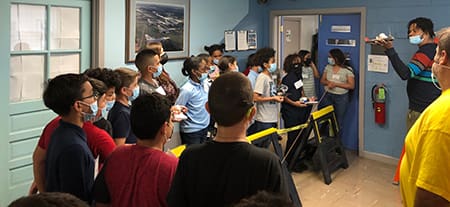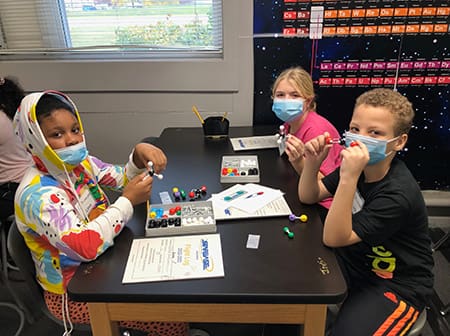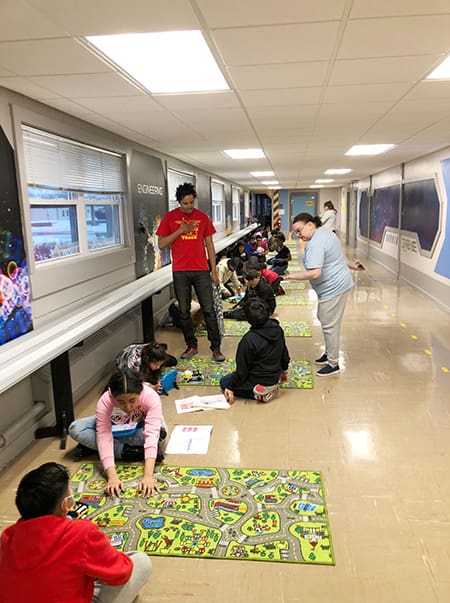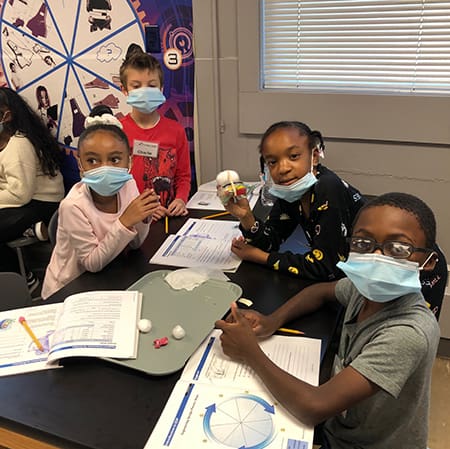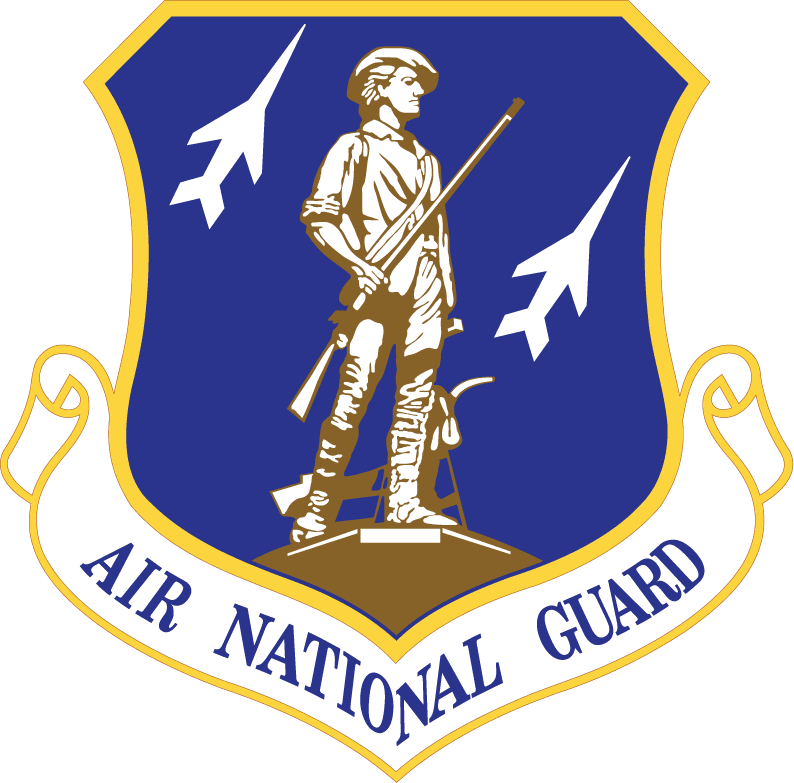A STARBASE Wisconsin instructor prepares to launch a mock-up shuttle bearing a student-made egg restraint system down a zip line into a concrete wall during a Feb. 27 session on engineering at STARBASE Wisconsin, a Department of Defense initiative to grow interest in science, technology, engineering and math in America’s youth. The designs were later tested on an indoor zip line. STARBASE Wisconsin photo
STARBASE Wisconsin is a big deal for fifth-grade students in Milwaukee — and it’s about to get bigger.
The Department of Defense initiative to spark interest in science, technology, engineering and math (STEM) has been in operation since February 2012 at the U.S. Army Reserve Center on Silver Spring Drive. More than 60 students from three schools graduated the inaugural Wisconsin STARBASE class. Since then, the program has supported more than 10,500 Milwaukee fifth-graders.
“STARBASE Wisconsin is one of the best hands-on science programs in the nation,” said John Puttre, STARBASE Wisconsin director and a retired Wisconsin Air National Guard colonel. “It’s free to all students, and it’s in our back yard.”
Fifth-grade students in Milwaukee display molecular models they made during an Oct. 12, 2022 session at STARBASE Wisconsin, a Department of Defense initiative to grow interest in science, technology, engineering and math in America’s youth. STARBASE Wisconsin photo
The STARBASE program targets students historically underrepresented in STEM — including those in inner cities or rural locations, socio-economically disadvantaged, low academic performers, and students with disabilities. STARBASE encourages students to set goals, and then achieve them.
At present, STARBASE Wisconsin provides 25 hours of instruction for each session, covering such topics as basic chemistry, physics, computer-aided design, robotics, energy exploration and the engineering design process. The program also incorporates teamwork and respect for team members’ thoughts and input.
The program had offered 60 classes of up to 32 students during the normal school year with additional specialized summer programs, out of two classrooms on the U.S. Army Reserve installation, but Puttre said a third class was added in February, which will boost this school year’s class total to 71. Next year STARBASE will offer 90 classes accommodating approximately 2,500 students, or roughly half the fifth-grade population in the Milwaukee Public School system.
“The challenge we have with adding a third class each session is busing shortages and Milwaukee Public School day schedules,” Puttre said. “MPS has early and late start schedules, which complicates schools’ ability being able to get students to STARBASE for five hours during the day with the associated bus shortage. It’s a challenge every day for the bus companies and our participating schools.”
STARBASE Wisconsin instructors answer questions from Milwaukee fifth-grade students during a class on robotics. STARBASE is a Department of Defense initiative to grow interest in science, technology, engineering and math in America’s youth. STARBASE Wisconsin photo
It’s worth tackling those challenges, Puttre said, as STARBASE Wisconsin has a waiting list of schools after filling its current 60 classes. Lessons typically consist of 20-30 minutes of instruction, followed by hands-on application of that instruction in groups of two or four on a class project or experiment.
“There is no better way to get them interested and keep their interest in STEM than letting them do it themselves,” Puttre said. He explained how students learn to create a restraint system to protect an egg. They are divided into groups of four and given $900 in pretend project money to “purchase” materials to build the restraint system, and students have to keep in mind the cost of materials needed for design changes. After a short time to plan out their design, the students put the raw egg on a mock-up of a space shuttle using their restraint system, and test it on a small zip line sliding the shuttle into a solid wall.
“Students learn the engineering design process applies to everyday life, especially if they become entrepreneurs,” Puttre said. “They have to explain what they are doing. They have to account for how they spend money. Sometimes they have to start over, and sometimes they learn their initial ideas don’t work.”
Fifth-grade students in Milwaukee display their egg restraint design during a Feb. 27 session on engineering at STARBASE Wisconsin, a Department of Defense initiative to grow interest in science, technology, engineering and math in America’s youth. The designs were later tested on an indoor zip line. STARBASE Wisconsin photo
STARBASE also holds an after-school aviation program for middle school students. The 30-hour course combines classroom instruction with desktop flight simulators.
“The students learn the physics behind flight, map reading, flight planning, and flying the Cessna 172 flight simulator between airports in Wisconsin using their aviation maps and flight plans they created,” Puttre explained.
STARBASE also collaborates each year with the Boy Scouts for their STEM and Aviation Merit Badge weekends, the Southeast Wisconsin Girls in Aviation organization, and the Wisconsin Association of Colleges and Employers (ACE) program held at General Mitchell International Airport in Milwaukee.
Civil engineers from the 128th Air Refueling Wing in Milwaukee will remove two walls in the STARBASE building to provide the third classroom. In addition to allowing for more students, the third classroom will allow the computer lab to be used for robotics and computer aided design incorporating 3-D printing.
The STARBASE program began in 1991 as an innovative collaboration between a Detroit teacher and the Michigan Air National Guard. The Department of Defense piloted the program in seven states in 1993. Today STARBASE works with students in 79 locations, including Puerto Rico and Guam.

